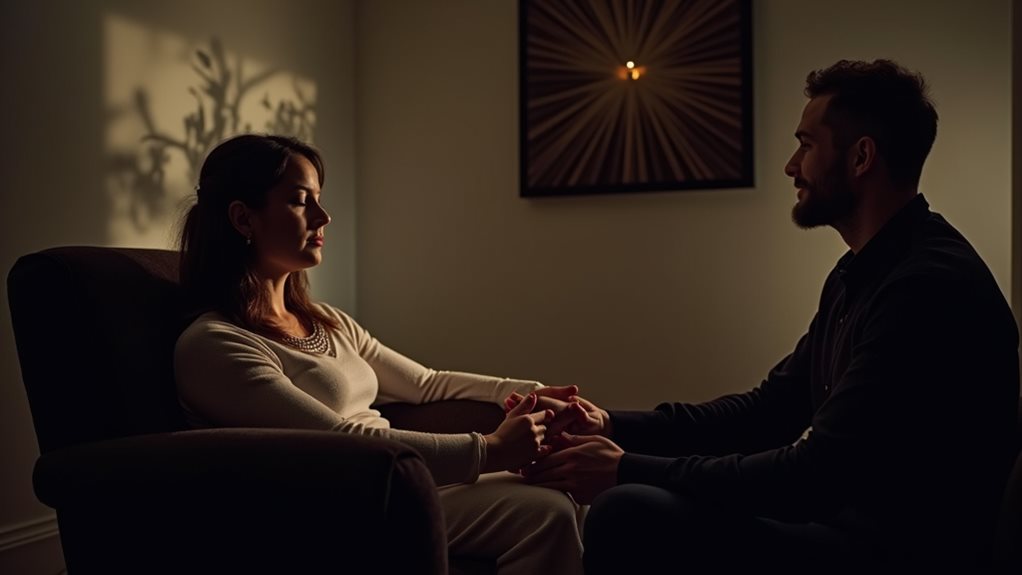
To effectively conquer mascot fears, it is crucial to acknowledge the psychological roots such as trauma or discomfort caused by their exaggerated and expressionless features. Techniques like gradual exposure therapy, hypnosis, Emotional Freedom Techniques (EFT), and Neuro-Linguistic Programming (NLP) are instrumental. These methods not only foster psychological resilience but also recalibrate emotional responses, easing the intensity of fear. By engaging in these structured approaches, one empowers themselves towards lasting emotional empowerment and confidence. Exploring these options further can provide deeper insights and thorough solutions.
Key Takeaways
- Gradual exposure therapy progressively acclimatizes individuals to mascots, reducing fear through controlled, safe encounters.
- Hypnosis accesses the subconscious to understand and reframe negative perceptions associated with mascots, promoting healing.
- Emotional Freedom Techniques (EFT) tap into body meridians to diminish the emotional impact of mascot fears by restoring energy balance.
- Neuro-Linguistic Programming (NLP) reprograms thought patterns about mascots, replacing fear with curiosity and empowerment.
- Identifying specific triggers of mascot fear is crucial, aiding in tailoring personalized therapeutic interventions.
Understanding the Root Causes of Mascot Fear
While many individuals enjoy the playful antics of mascots at sports events and parades, others experience a profound discomfort or fear around these oversized, costumed figures.
This fear, often rooted in psychological factors, can stem from trauma triggers linked to past negative experiences. The exaggerated, often expressionless features of mascots can evoke a sense of unpredictability and anonymity, intensifying feelings of unease or threat.
Understanding these triggers is essential in addressing mascot phobia effectively. Analyzing the specific aspects of mascots that induce fear helps tailor therapeutic approaches, aiming to mitigate these deep-seated anxieties through targeted psychological interventions.
The Role of Gradual Exposure in Overcoming Phobias
Gradual exposure therapy plays a critical role in the therapeutic process of overcoming phobias, including the intense fear of mascots. This method involves a structured approach where individuals are exposed to their fears incrementally, according to a predetermined fear hierarchy. The process is designed to minimize anxiety at each step.
- Assessment: Establishing the individual's specific fears and creating a personalized exposure plan.
- Controlled Exposure: Introducing the fear object (mascots) in a controlled, safe environment.
- Skill Development: Teaching coping mechanisms to handle anxiety during exposure.
- Progression: Gradually increasing the intensity of exposure based on the client's comfort and progress.
How Hypnosis Can Help Address Deep-Rooted Fears

Building on the foundation laid by gradual exposure therapy, hypnosis offers a profound method for addressing the roots of mascot fear that may not be fully accessible through conscious strategies alone.
By delving into the subconscious, hypnosis techniques facilitate a form of subconscious healing that can uncover and reinterpret the origins of deep-seated anxieties.
Through this process, individuals are enabled to reframe their perceptions and emotional responses toward mascots.
This scientific approach not only empathizes with the sufferer's experience but also provides a robust framework for enduring psychological change, ultimately fostering a more empowered and less fearful existence.
The Benefits of Emotional Freedom Techniques (EFT)
How can Emotional Freedom Techniques (EFT) alleviate the intense fears associated with mascots?
EFT techniques involve tapping specific body meridians while focusing on emotional distress. This method is rooted in the principles of energy psychology, which posits that emotional distress disrupts the body's energy system.
By tapping, EFT aims to restore balance and facilitate emotional regulation. Here are specific benefits:
- Reduces intensity of fear by recalibrating the body's energy system.
- Enhances emotional regulation, helping individuals manage anxiety responses.
- Provides a self-help tool that individuals can use in anxiety-triggering situations.
- Supports overall emotional health by addressing underlying emotional disturbances.
Rewiring Your Brain With Neuro-Linguistic Programming (NLP)

Rewiring the brain using Neuro-Linguistic Programming (NLP) offers a profound approach to altering entrenched patterns of thought and behavior that underlie mascot fears. By applying NLP techniques, individuals can reprogram their beliefs, effectively transforming their emotional landscape. This methodical reconditioning fosters a new perception of mascots, replacing fear with neutrality or even positivity.
| Emotion Before NLP | NLP Technique | Emotion After NLP |
|---|---|---|
| Anxiety | Anchoring | Calmness |
| Helplessness | Reframing | Empowerment |
| Dread | Visualization | Curiosity |
This table illustrates the transformative potential of NLP, guiding individuals from negative to positive emotional states.
Strategies for Building Confidence and Emotional Empowerment
As the application of Neuro-Linguistic Programming (NLP) helps individuals reshape their perceptions of mascots from fearful to neutral or positive, it naturally enhances their overall confidence and emotional resilience.
This transformation is pivotal in self esteem building and anxiety management.
Key strategies include:
- Challenging Negative Beliefs: Identifying and restructuring negative thoughts about mascots.
- Relaxation Techniques: Employing methods such as deep breathing to manage anxiety in mascot encounters.
- Incremental Exposure: Gradually increasing interaction with mascots to build tolerance.
- Positive Reinforcement: Celebrating small victories to foster a positive association and boost confidence.
Finding the Right Practitioner and Additional Resources

Selecting the right practitioner is crucial for effectively addressing mascot fears, as the qualifications and approach of the therapist can greatly influence the success of the treatment. It's essential to choose someone with specialized training in phobia management. Here are some additional resources and qualifications to take into account:
| Resource | Description |
|---|---|
| Accredited Training | Guarantees practitioner has met required standards |
| Therapy Reviews | Provides insight from previous patients |
| Licensing Bodies | Offers validation of practitioner's credentials |
| Support Groups | Facilitates shared experiences and coping methods |
Selecting a practitioner with the right qualifications enhances therapy outcomes.
Frequently Asked Questions
How Long Does It Take to Overcome Mascot Phobia?
The duration to overcome mascot phobia varies among individuals. Techniques like exposure therapy and gradual desensitization typically yield results over weeks to months, depending on the severity of the fear and frequency of therapy sessions.
Are There Age Limits for Using These Phobia Resolution Techniques?
Age appropriateness varies for phobia resolution techniques, but generally, treatment is accessible to individuals of all ages with adaptations suited to developmental levels, ensuring both safety and effectiveness in therapeutic approaches.
Can Mascot Fears Return Even After Successful Treatment?
Mascot fears can return post-treatment if new mascot triggers are encountered or if underlying issues remain unresolved. Continuous management and reinforcement of coping strategies are essential to prevent fear relapse and maintain progress.
What Are the Risks of Ignoring Mascot Phobia?
Ignoring mascot phobia can lead to persistent mascot avoidance, escalating emotional distress. This avoidance often exacerbates fear, potentially hindering social interactions and quality of life, and can contribute to broader anxiety disorders if left unaddressed.
How Do Cultural Differences Impact Mascot Phobia Treatment?
Cultural differences shape treatment of mascot phobia considerably. Diverse cultural perceptions influence acceptance and effectiveness of various approaches, requiring adaptations in therapy techniques to align with localized beliefs and practices about mascots.
Conclusion
In summary, overcoming mascot phobia requires a multifaceted approach, blending scientific and psychological strategies. Techniques like hypnosis, EFT, and NLP offer substantial promise, addressing the subconscious influences and rewiring emotional responses. Gradual exposure and cognitive-behavioral methods further empower individuals, fostering resilience. Ultimately, selecting a qualified practitioner is essential, ensuring a tailored and effective therapeutic journey towards emotional liberation and the mastery of one's fears, transforming trepidation into triumph.





